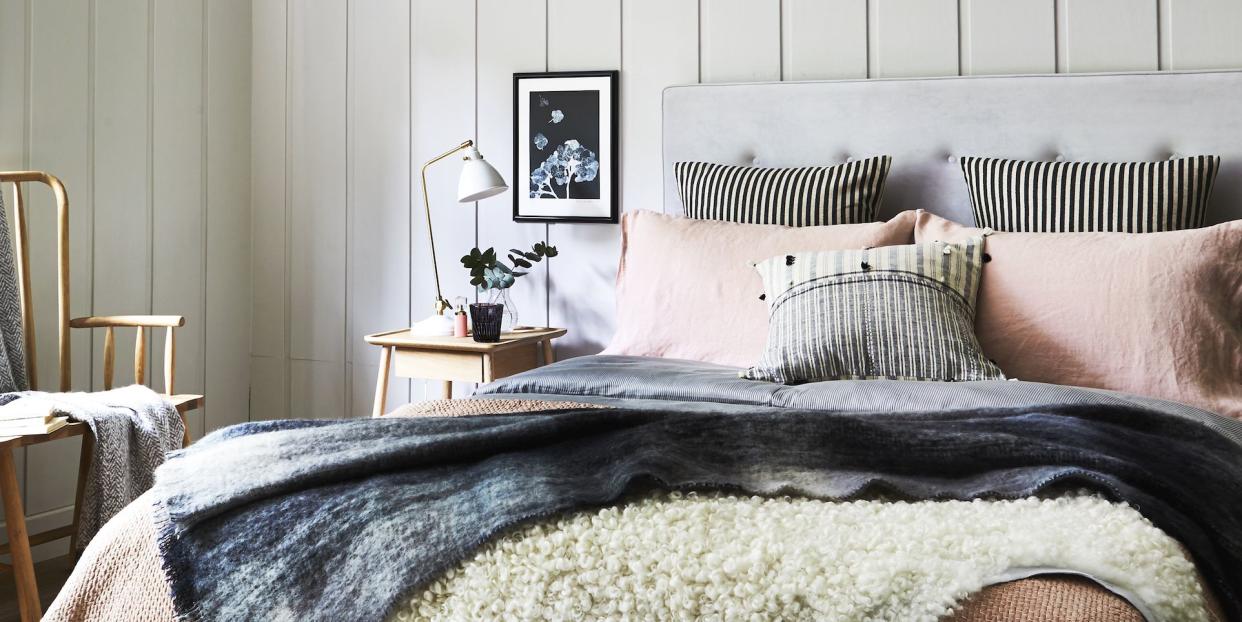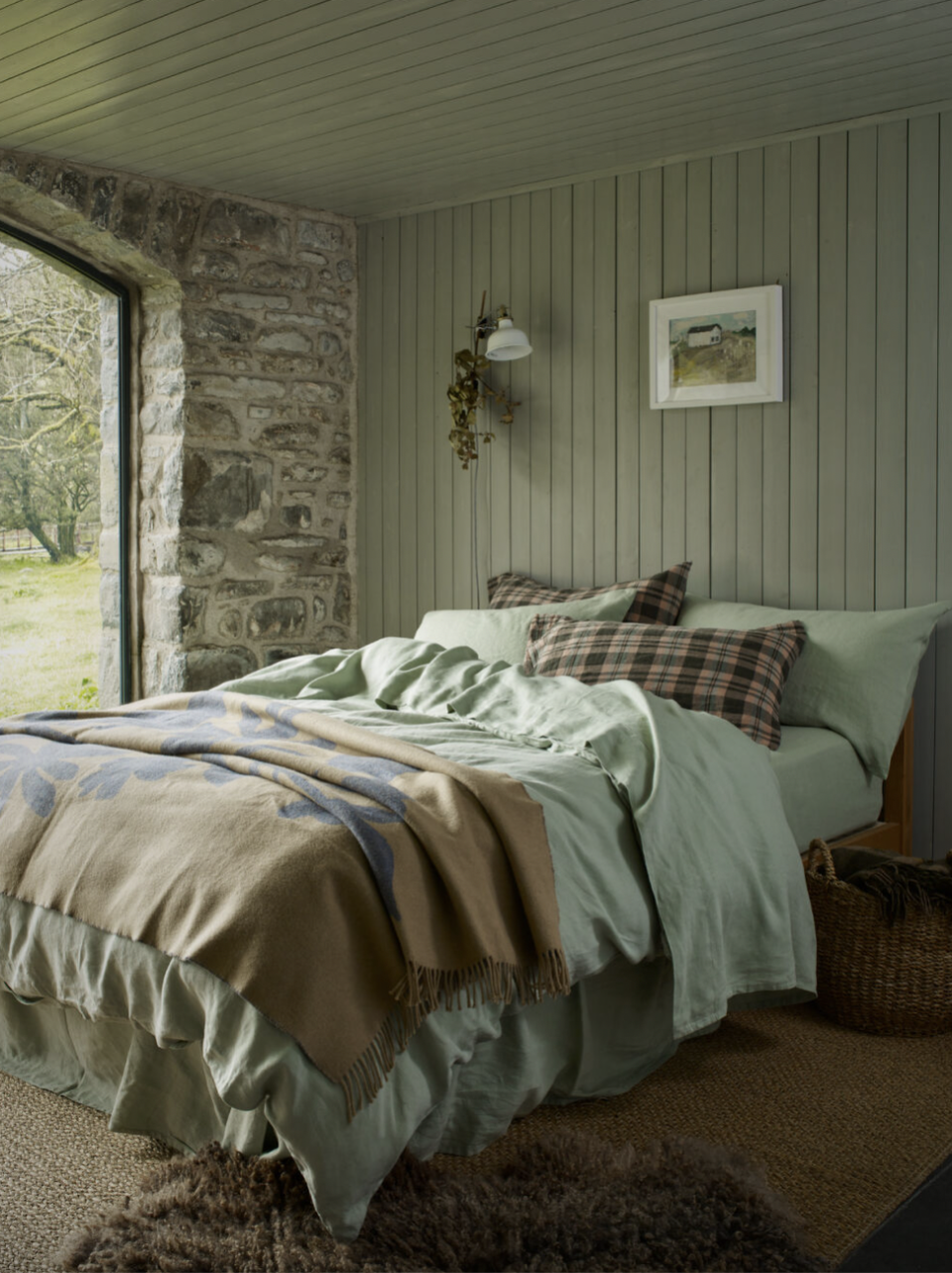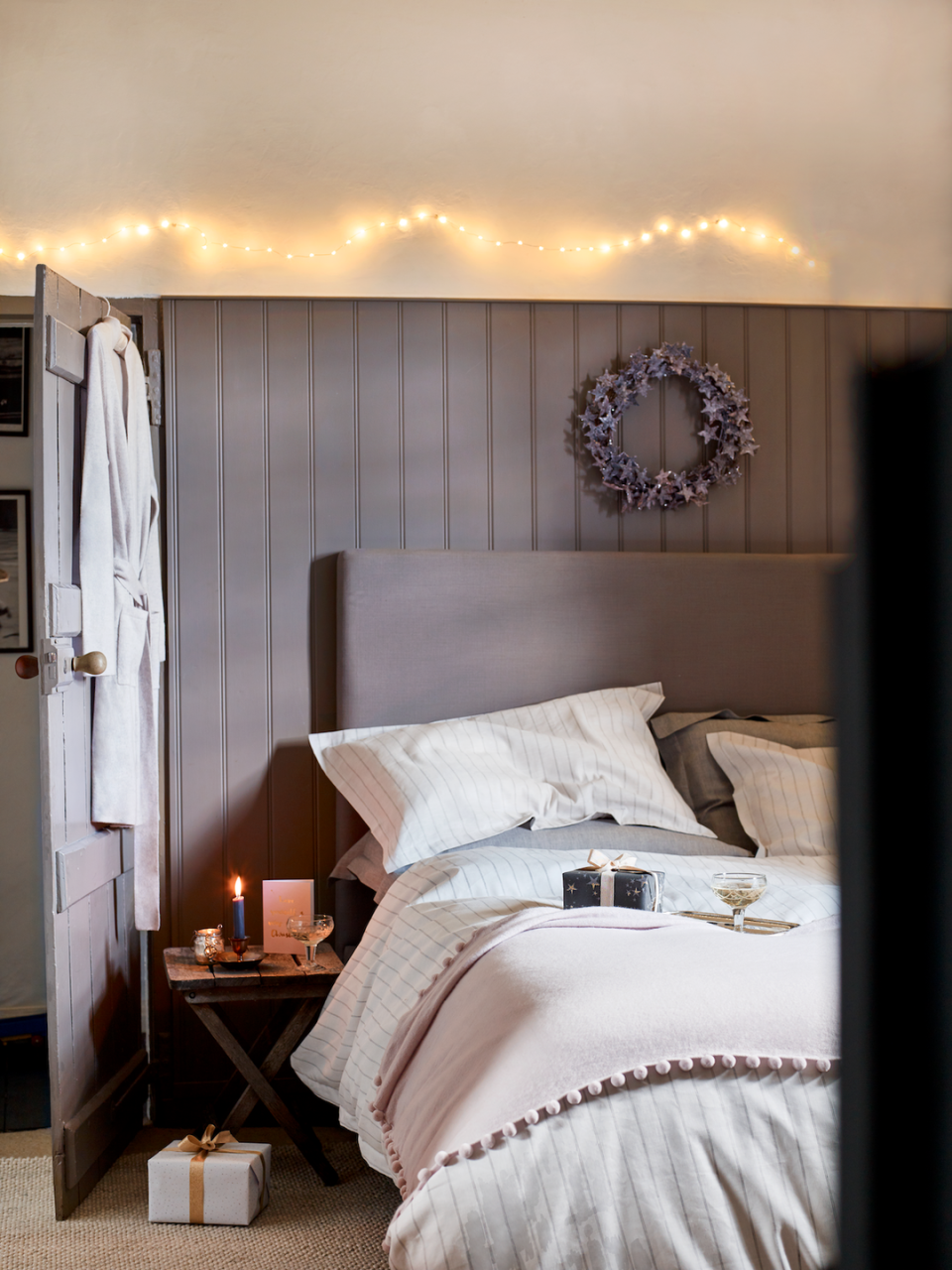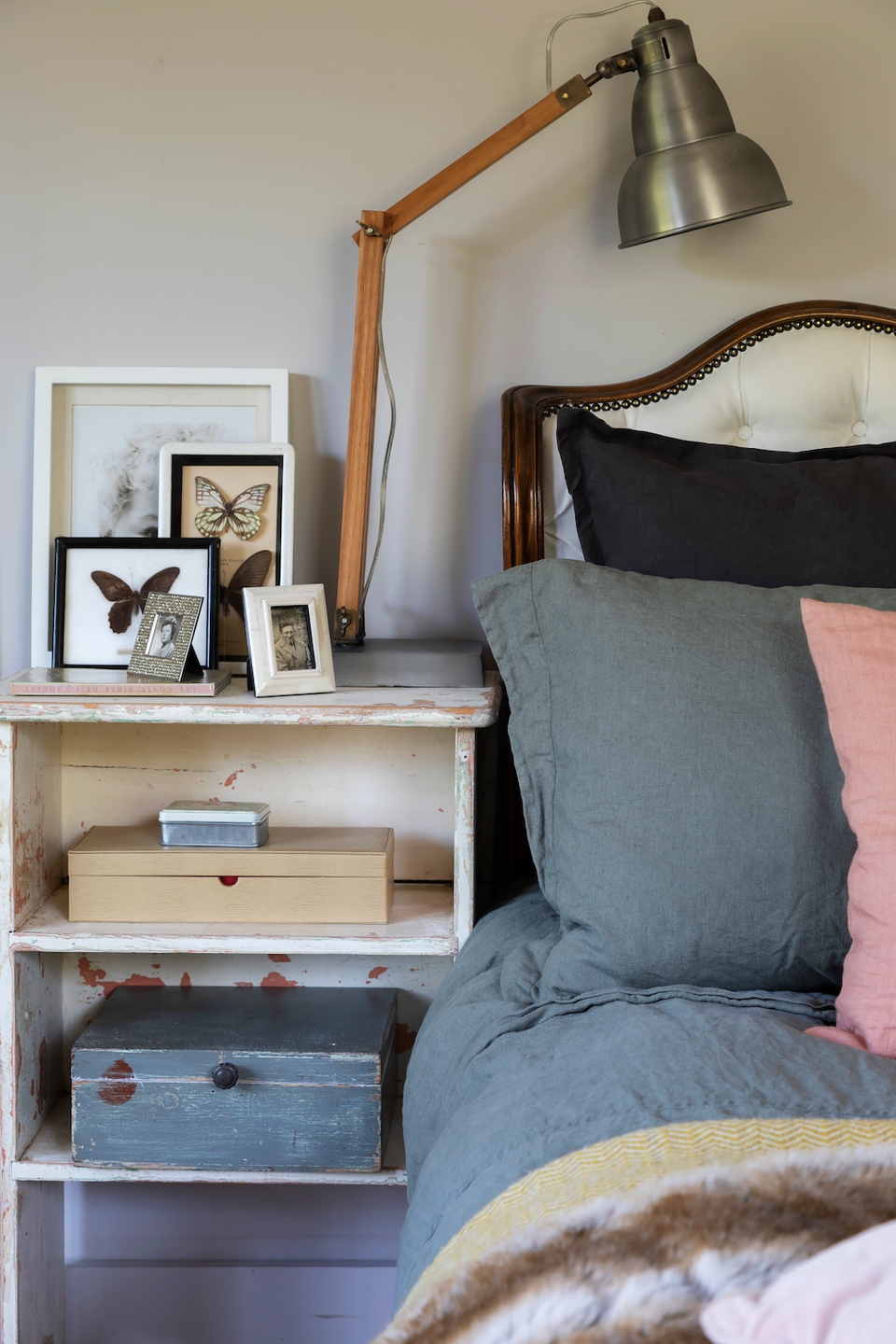5 expert tips for adding a touch of hygge to your bedroom

It’s cold and dark outside, which means it’s time to embrace all things hygge (pronounced ‘hoo-gah’, if you're struggling) – aka the Danish art of cosying up. We think turning your bedroom into a cosy, hygge-inspired haven is the best way to ride out hibernation season.
So, what exactly is hygge? Visit Denmark sums it up perfectly: 'The warm glow of candlelight is hygge. Cosying up with a loved one for a movie – that’s hygge, too.'
'The darker and longer the nights get, the cosier we want our homes to feel,' says Luke Bilham-Carter, interior design expert and design director at Canopy Visual.
'Look no further than the Danes, who have their own word for the perfect balance of cosiness and comfort. It’s a feeling of calm and welcomeness, letting go of the hectic world around us and wrapping up in our favourite blanket with a mug of hot chocolate.'
Think all things comforting and cosy – ultra-soft throws, ambient lighting and nature-inspired shades. Keep reading to learn how to get the hygge look and feel just right in your bedroom.
Tip 1: Get layering just right
Joanna Ross, general manager of design at Sheridan, says layering is key in a hygge-inspired bedroom: 'Creating a hygge bedroom ultimately means creating a space that brings you peace and stillness. The bedroom is arguably the room that would benefit from this the most as it’s the room you relax in and the more relaxed you are, the better you sleep.
'One of my favourite ways to achieve hygge in the bedroom is by layering. Think cushions and throws that add warmth and texture. You can have a lot of fun with contrasting different materials which makes your bed the focal piece of the room. My only advice is don’t go overboard with the cushions or decorative elements. Less can be perfect in your pursuit of relaxation. Just stick with a very select edit focusing on tactility and comfort.'

Start with a brushed cotton duvet cover and sheets to build a cosy base. Then, add boucle or faux fur cushions for a comfy place to rest your head. Lastly, we recommend at least two throws or blankets on hand to keep you extra toasty. Choose a lighter option, such as cotton or lightly woven throw, then add a more densely textured and thicker blanket on top – fleece, faux fur, or a chunky knit are all great finishing touches.
Luke advises: 'If you ensure that the colours you choose throughout your bedroom are relatively uniform, then you can be more expressive with materials and textures. Faux fur blankets, soft bedding and chunky knit throws go hand-in-hand with refined velvet cushions.'
Bonus tip: 'Having a duvet one size bigger than your bed frame is a game changer not only from a practical POV (everyone benefits from some extra duvet square footage) but also aesthetically,' says Etsy’s trend expert, Dayna Isom Johnson. 'An oversized duvet immediately adds a cosy warm vibe and is particularly effective if you have a bed that is lower to the ground'.
Tip 2: Use a warming colour palette
There's a lot to be said about the impact colour has on our mood, as well as how it can transform the feel of our interior. To create a sanctuary-like atmosphere, avoid stark shades and instead, opt for those that warm things up, even subtly.
Matthew Williamson, suggests: 'To create the ultimate cosy bedroom, try using a soft plaster pink on the walls – it feels like a new neutral, but it’s warmer than grey and more interesting than beige. For easy updates, consider investing in accessories such as velvet cushions and printed bed throws in rich chocolate, cinnamon and burnt orange tones. I feel this palette will work well against the soft pink and add warmth to the bedroom as we hunker down and head towards winter.'
Luke agrees: 'The mood of a room, especially a bedroom, is heavily dependent on what colours and textures you surround yourself with. Earthy browns, forest greens, and claret reds will create that warming feeling that is paramount to a winter interior.
'Simply swapping things like wall art, cushions, bedding, and lampshades, will be enough to adjust the colour scheme of the room without making it too dark and moody.'
Shades found in nature soothe and relax us, promoting a sense of calm within our home. Deeper hues (such as rich green tones) cocoon us by adding depth and a sense of warmth to the space. Opting for these dark yet warming tones creates a cosy hideaway from the chilly world outside.
Bonus tip: 'Incorporating accents of wood and nature is the perfect way of bridging hard and soft and creating a seamless hygge vibe,' advises Dayna.
Tip 3: Use lighting to create a cosy, cocoon-like feeling
Let's be honest, bright lights are the opposite of cosy. This is especially true in bedrooms, a space we wind down and relax in. To add a feeling of hygge to your bedroom, forget bright ceiling lights and opt for a mixture of other, softer lighting options, such as bedside lamps and candles.
'Table lamps are particularly effective in the autumn and winter months when natural light isn't particularly bright,' says Niki Wright, co-founder of lights&lamps. 'Simply switching on a lamp can change the feeling of an entire room and add calmness and warmth. As the evenings draw in, additional lamps placed at different heights or in various corners and nooks extenuate that cosiness; adding practical light without taking from the ambience.'

Luke suggests keeping things understated: 'For the winter mood, think natural. Leave the fairy lights for the Christmas tree. Candles not only contribute to the scent of your room, but they also provide a lovely natural lowlight in the evenings that few other lighting options can.
'For more conventional light options, consider bulbs emitting soft orange hues rather than bright whites to add further warmth. Filament bulbs are a great option and very energy efficient.'
Bonus tip: 'Hygge recognises the importance of warmth and joy, so use warm, soft lighting,' says James Higgins, sleep expert and CEO of Ethical Bedding. 'You could create a magical atmosphere with fairy lights, draped across walls or around the bed, or use natural light to enhance the bedroom’s aesthetics, making spaces feel open.'
Tip 4: Appeal to the senses
When it comes to creating an inviting atmosphere in your hygge bedroom, aroma can help set the scene. Plus, scented candles have the added benefit of providing a lovely warming glow, too. If you choose correctly, the right scent will add an incredibly luxurious feel to your home and also help you unwind and relax.
Luke explains: 'Candles are a good way of lifting the aroma towards winter and diffusers are another great option. If you're feeling particularly adventurous, there's a whole world of pillow mists out there. Go ahead, look it up, it's like cologne for your pillows.'
In terms of scents, he suggests the following: 'Focus on cloves, cinnamon, ginger. Musky scents all leave us with heads full of winter cooking and festive memories.'
Tip 5: Choose comforting homeware
Forget trends, decor that sparks joy and makes us feel comforted is key to creating a sense of hygge in our bedroom.
James says: 'It’s vitally important to incorporate personal mementoes, family photos, or souvenirs into your decor. The heart of hygge is all about creating a space where you feel connected and safe. Every personal item has a story behind it. These stories weave a narrative that can be shared with family and friends, further enriching the hygge experience of togetherness and shared memories.'

Bringing nature inside our home also helps to soothe us, bridging the gap between our bedroom and the world outside. Greenery also helps remind us of spring and the year ahead.
'Plants play a significant role in the hygge philosophy,' says James. 'With simplicity at its core, plants provide a direct connection to nature, grounding us and reminding us of the beauty of simplicity.
'Using indoor plants will not only look aesthetically pleasing but also have dual benefits. They naturally purify the air by absorbing toxins and releasing oxygen, which not only contributes to a healthier living environment but also resonates with the hygge principle of creating spaces that promote well-being.'
Follow House Beautiful on Instagram.
You Might Also Like



